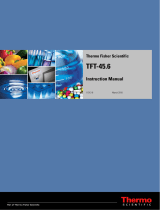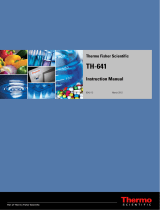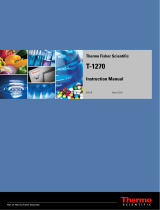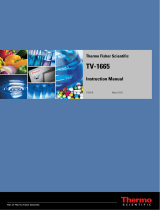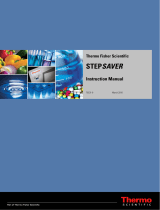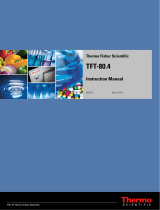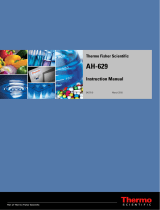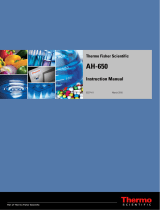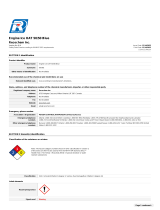Page is loading ...

8326-10 March 2010
Thermo Fisher Scientific
T-647.5
Instruction Manual

© 2009 Thermo Fisher Scientific Inc. All rights reserved.
ULTRACRIMP< is either a registered trademark or a trademark of Thermo Fisher Scientific.
All other trademarks are the property of Thermo Fisher Scientific Inc. and its subsidiaries.
Thermo Fisher Scientific Inc. provides this document to its customers with a product purchase to use in the
product operation. This document is copyright protected and any reproduction of the whole or any part of this
document is strictly prohibited, except with the written authorization of Thermo Fisher Scientific Inc.
The contents of this document are subject to change without notice. All technical information in this
document is for reference purposes only. System configurations and specifications in this document supersede
all previous information received by the purchaser.
Thermo Fisher Scientific Inc. makes no representations that this document is complete, accurate or error-
free and assumes no responsibility and will not be liable for any errors, omissions, damage or loss that might
result from any use of this document, even if the information in the document is followed properly.
This document is not part of any sales contract between Thermo Fisher Scientific Inc. and a purchaser. This
document shall in no way govern or modify any Terms and Conditions of Sale, which Terms and Conditions of
Sale shall govern all conflicting information between the two documents.
Release history: 8326-10 printed in March 2010.
For Research Use Only. Not for use in diagnostic procedures.

Thermo Scientific T-647.5 i
T
Thermo Scientific T-647.5 Titanium Fixed-Angle Ultra-speed Centrifuge Rotor .......... ii
Important Safety Information ................................................................................................. iii
Chapter 1 DESCRIPTION ........................................................................................................................ 1-1
Rotor Description .................................................................................................... 1-2
Rotor Specifications ................................................................................................. 1-2
Accessories ............................................................................................................... 1-3
Chapter 2 OPERATION ............................................................................................................................ 2-1
Prerun Safety Checks ............................................................................................... 2-2
Compartment Loads in Excess of Design Mass ........................................................ 2-2
Critical Speed .......................................................................................................... 2-3
Rotor Precool .......................................................................................................... 2-3
Relative Centrifugal Force (RCF) Determination .................................................... 2-3
Chemical Compatibility .......................................................................................... 2-7
Rotor Balancing ....................................................................................................... 2-7
Rotor Loading and Sealing ....................................................................................... 2-8
Ultracentrifuge / Rotor Log Book ............................................................................ 2-9
Chapter 3 CARE and MAINTENANCE ................................................................................................... 3-1
Corrosion ................................................................................................................ 3-2
Cleaning .................................................................................................................. 3-2
Storage ..................................................................................................................... 3-4
Overspeed Decal Replacement ................................................................................. 3-4
Service Decontamination Policy .............................................................................. 3-5
Chemical Compatibility Chart ...............................................................................A-1
Contact Information ................................................................................................B-1
Table of contents

Thermo Scientific T-647.5 ii
P
This manual is a guide for the use of
Thermo Scientific T-647.5 Titanium Fixed-Angle
Ultra-speed Centrifuge Rotor
Data herein has been verified and is believed adequate for the intended use of the rotor. Because failure
to follow the recommendations set forth in this manual could produce personal injury or property
damage, always follow the recommendations set forth herein. Thermo Fisher Scientific does not
guarantee results and assumes no obligation for the performance of rotors or other products that are
not used in accordance with the instructions provided. This publication is not a license to operate
under, nor a recommendation to infringe upon, any process patents.
Publications prior to the Issue Date of this manual may contain data in apparent conflict with that
provided herein. Please consider all data in this manual to be the most current.
NOTES, CAUTIONS, and WARNINGS within the text of this manual are used to emphasize
important and critical instructions.
WARNING informs the operator of a hazard or unsafe practice that could result in personal injury,
affect the operator's health, or contaminate the environment.
CAUTION informs the operator of an unsafe practice that could result in damage of equipment.
NOTE highlights essential information.
© 1983, 1997, 1999, 2008, 2010 by Thermo Fisher Scientific
CAUTION and WARNING are accompanied by a hazard symbol and appear near the
information they correspond to.

Preface
iii T-647.5 Thermo Scientific
Important Safety Information
Certain potentially dangerous conditions are inherent to the use of all centrifuge rotors. To ensure safe
operation of this rotor, anyone using it should be aware of all safe practices and take all precautions
described below and throughout this manual.
WARNING
When using radioactive, toxic, or pathogenic materials, be aware of all characteristics of
the materials and the hazards associated with them in the event leakage occurs during
centrifugation. In the event of a rotor failure, neither the centrifuge nor the rotor can
protect you from particles dispersed in the air. To protect yourself, we recommend
additional precautions be taken to prevent exposure to these materials, for example, use of
controlled ventilation or isolation areas.
Always be aware of the possibility of contamination when using radioactive, toxic, or
pathogenic materials. Take all necessary precautions and use appropriate decontamination
procedures if exposure occurs.
Never use any material capable of producing flammable or explosive vapors or creating
extreme exothermic reactions.
Never exceed the maximum rated speed of the installed rotor; to do so can cause rotor
failure.
Always reduce (derate) rotor speed as instructed in this manual whenever:
•the rotor speed/temperature combination exceeds the solubility of the gradient
material and causes it to precipitate.
•the compartment load exceeds the maximum allowable compartment load specified.
See Chapter 2, Compartment Loads in Excess of Design Mass.
Failuer to reduce rotor speed under these conditions can cause rotor failure

Preface
Thermo Scientific T-647.5 iv
CAUTION
Do not expose aluminum rotor components to: strong acids, bases, or alkaline laboratory
detergents; liquid chlorine bleach; or salts (chlorides) of heavy metals such as cesium, lead,
silver, or mercury. Use of these materials with aluminum can cause a chemical reaction that
initiates corrosion.
Do not operate or precool a rotor at the critical speed, as this will have a detrimental effect
on centrifuge component life. See Chapter 2, Operation.
Do not operate the rotor unless it is symmetrically balanced as described in this manual.
Operating the rotor out of balance can cause damage to the centrifuge drive assembly.
Do not operate the rotor without the cover in position and locked in place and the rotor
locked to the centrifuge drive. See Chapter 2, Operation.
Always maintain the rotor in the recommended manner. The rotor and all accessories
should be clean and inspected prior to each run; do not use rotors showing signs of
corrosion or cracking. See Chapter 3, Care and Maintenance.
Do not autoclave or expose any aluminum rotor body and cover or expose any aluminum
rotor parts to temperatures in excess of 100°C.

Thermo Scientific T-647.5 1-1
1
DESCRIPTION
This manual provides you with the information you will need to operate and maintain your Thermo
Scientific T-647.5 Fixed-Angle Ultracentrifuge Rotor. If you encounter any problem concerning either
operation or maintenance that is not covered in the manual, contact Thermo Fisher Scientific for
assistance. In the United States, telephone toll free 1-866-9THERMO. Outside the United States,
contact your distributor or agent for Thermo Fisher Scientific products. Thermo Fisher Scientific
product information is available on our internet web site at http:// www.thermo.com/centrifuge .
Contents
•“Rotor Description” on page 1-2
•“Rotor Specifications” on page 1-2
•“Accessories” on page 1-3

1 DESCRIPTION
Rotor Description
1-2 T-647.5 Thermo Scientific
Rotor Description
The T-647.5 is a six-place fixed-angle ultracentrifuge rotor that can be used at speeds up to 47,500
rpm.1 The rotor body is machined from a titanium forging for strength and corrosion resistance. The
aluminum lid and locking nut are given a blue anodized finish for surface protection. The rotor is
tightly sealed during operation by the rotor lid and two O-rings - one that fits inside the rotor lid and
another around the bottom of the aluminum locking nut. The six tube compartments are bored at a
22.5° angle to the axis of rotation. A disc with alternative black and reflective segments attached to
the bottom of the rotor provides overspeed protection.
Rotor Specifications
1Speed in revolutions per minute (rpm) is related to angular velocity, w, according to the following:
Where w = rad/s. All further references in this manual to speed will be designated as rpm.
ω(rpm)=2π
60
------
⎝⎠
⎛⎞ rpm()0.10472()=
Table 1-1.Rotor Specifications
Rotor Type Fixed Angle
Maximum Speed (rpm) 47,500*
*With tubes filled with a non-precipitating homogenous solution having an average density of 1.2 g/ml or less.
Relative Centrifugal Force (RCF) at Max. Speed
- at rmaximum 9.93 cm 250,259
- at raverage 6.66 cm 167.847
- at rminimum 3.39 cm 85.436
K Factor at Maximum Speed 114
Critical Speed 1000 rpm
Tube Size (Maximum) 39 mm x 107 mm
Number of Tube Compartments 6
Nominal Tube Capacity 90 ml
Total Rotor Capacity (Nominal) 540 ml
Maximum Tube Compartment Mass 157.6 grams
Tube Angle 22.5°
Rotor Diameter 19.5 cm (7.5 in)
Rotor Weight (empty) 11 kg (24.2 lbs)

1 DESCRIPTION
Accessories
Thermo Scientific T-647.5 1-3
Accessories
Accessories Supplied
The accessories supplied with the T-647.5 Rotor, Catalog No. 54304 (rotor and complete accessories),
are listed in Table 1-2. Those items indicated by an asterisk (*) are not supplied with Catalog No.
08322, which is a T-647.5 with basic accessories only.
To order replacement accessories, telephone 1-866-9THERMO in the United States. Outside the
United States, contact the local representative, distributor or agent for Thermo Fisher Scientific
products. Be sure to provide a description of the part, the catalog number, plus the rotor model and
serial number.
Optional Multipiece Sealing Assembly
If you prefer, you can use the T-647.5 Rotor with thinwall poly-allomer tubes and aluminum sealing
cap assemblies. The sealing assemblies consist of a tube plug, a tube plug cover, a sealing nut, and a
post-fill screw. When the assembly is tightened, the cover crimps the top of the tube to form a seal. In
order to use the rotor with this sealing assembly, you must purchase all items separately: the T-647.5
Rotor with basic accessories only, Catalog No. 08322; Tool Kit, Catalog No. 52988; the tubes and the
sealing assembly components. Table 1-3 lists the catalog number and description of the tubes and
Note In order to seal the ULTRACRIMP< Tubes, (supplied with Catalog No. 54304) you must
have an ULTRACRIMP® Sealing Tool, Catalog No. 03920.
Table 1-2. Accessories Supplied
Qty. Catalog No. Description
8 03990*
*Not supplied with Catalog No. 08322 (basic accessories only).
ULTRACRIMP® Tubes, 90 ml (pkg/25)**
**Each package of tubes is supplied with an equal number of tube caps and tube plugs.
6 03998*Rotor Cap
1 03940*Tube Racks, 3-place (1 pair)
1 12826*ULTRACRIMP® Tube Removal Tool
1 51942 Rotor Stand
1 65937 Vacuum Grease
1 61556 Lubricant
1 51350 Overspeed Decal, 47 500 rpm (extra)
1 64668 Rotor Cover O-ring, (extra)
1 64667 Locking Nut O-ring, (extra)
1 52392 Rotor Cover Tool
1 52384 Centrifuge/Rotor Log Book
1 08326 Instruction Manual

1 DESCRIPTION
Accessories
1-4 T-647.5 Thermo Scientific
sealing assembly components required, and Table 1-4 lists the parts supplied in the Tool Kit. If you
have the tools listed, you need not purchase the kit; or, if necessary, any of the tools listed can be
ordered separately by catalog number given in the table..
Rotor Cover Removal Tool
The rotor cover of the T-647.5 Rotor is designed to fit the rotor body tightly to ensure a positive seal;
however, because of this tight fit, it is sometimes difficult to remove. The catalog number for this tool
is 52652; complete instructions for use of the tool are supplied with it.
Table 1-3.Optional Multipiece Sealing Assembly Components
Catalog No. Description
03140 Tubes, 100 ml, Polyallomer (25/Pkg)
52571 Sealing Cap Assembly (each); 6 required
Table 1-4.Tool Kit (Catalog No. 52988) for use with Optional Sealing Assembly
Catalog No. Description
51834 Tube Cap Vise
52013 Tube Removal Tool (for Catalog No. 03140)
52881 Torque Wrench
66376 Socket, 7/8 inch
00693 Bottle Removal Tool

Thermo Scientific T-647.5 2-1
2
OPERATION
This chapter contains the information necessary to prepare the T-647.5 Ultraspeed Rotor for operation
and includes important safety information.
Contents
•“Prerun Safety Checks” on page 2-2
•“Compartment Loads in Excess of Design Mass” on page 2-2
•“Critical Speed” on page 2-3
•“Rotor Precool” on page 2-3
•“Relative Centrifugal Force (RCF) Determination” on page 2-3
•“Chemical Compatibility” on page 2-7
•“Rotor Balancing” on page 2-7
•“Rotor Loading and Sealing” on page 2-8
•“Ultracentrifuge / Rotor Log Book” on page 2-9

2 OPERATION
Prerun Safety Checks
2-2 T-647.5 Thermo Scientific
Prerun Safety Checks
To ensure safe performance of the rotor, before every run you should:
•read the Safety Information Page in the front of this manual.
•make sure each tube compartment is clean and that there is no sign of corrosion.
•be sure the rotor itself is clean and shows no sign of corrosion or cracking. Also, make sure there
are no scratches or burrs around the rim of the rotor.
•check the centrifuge chamber and drive spindle to be sure they are clean and free of scratches and
burrs.
•verify that proper overspeed decal is firmly attached to bottom of rotor; decal should have 19
black segments (see page 3-4 for Overspeed Decal Replacement).
•check the chemical compatibility of all materials used (see Appendix).
•inspect the rotor cover O-rings for cracks, tears, or abrasions; replace if necessary. Be sure the
O-rings are properly lubricated.
•make sure the rotor cover is on and properly tightened and that the rotor cover tool has been
removed from the locking nut.
•be sure the proper environment has been selected for operation; for example, controlled
ventilation or isolation, if required.
•check the top speed capability of the tube (or bottle) being used; observe the CAUTION.
Compartment Loads in Excess of Design Mass
The maximum operating speed (see Specifications, page 1-2) is based on the recommended design
mass that has been established for this rotor, representing the maximum mass that each tube
compartment can contain at top speed. To prevent rotor failure, the total contents of each
compartment (including specimen, tube, rotor cap, tube cap, and tube plug) should not exceed the
recommended figure unless the rotor speed is reduced proportionately. (If using optional sealing
assembly, include the weight of the complete assembly.)
WARNING The stresses that this rotor withstands during centrifugation gradually
weaken the rotor body, increasing the possibility of rotor failure. Thermo Fisher Scientific
warranties this rotor for the expected life of the product; and, for your safety, recommends
that this rotor be withdrawn from service after it has been used for 5000 runs. Failure to
do so can cause rotor failure with subsequent sample loss and damage to the rotor and/or
centrifuge. If the material being processed is hazardous, take all necessary precautions to
prevent exposure should rotor failure occur.
CAUTION When using a tube or bottle assembly other than those supplied by Thermo
Fisher Scientific, be sure to check the top speed capability; when in doubt, do a test run for
the desired application. If using a Thermo Fisher Scientific tube (or bottle) assembly other
than those supplied with the rotor, refer to the Product Guide for the maximum speed.
Exceeding the top speed capability of the tube (or bottle) can result in its breakage.

2 OPERATION
Critical Speed
Thermo Scientific T-647.5 2-3
Strict adherence to the maximum allowable compartment mass or reduced speed is required to prevent
rotor failure. Observe the WARNING.
The design mass for each compartment of the rotor is 157.6 g at 47 500 rpm for the T-647.5 Rotor.
This figure is based on the use of a ULTRACRIMP® polyallomer tubes, Catalog No. 03990, filled with
a liquid at 1.2 specific gravity, plus all sealing assembly components. If the total compartment mass is
greater than that figure, use the following formula to determine the reduced speed:
Critical Speed
The critical speed is that speed at which any rotor imbalance will produce a driving frequency equal to
the resonant frequency of the rotating system (that is, the rotor and the centrifuge drive). At this speed,
the rotor may produce large amplitude vibrations which can be felt in the centrifuge frame. Mass
imbalance will contribute to increased vibration intensity at critical speed. Avoid operating rotor at
critical speed (see page 1-1). Operation at the critical speed will have a detrimental effect on centrifuge
component life. Observe the CAUTION.
Rotor Precool
If samples are routinely processed around 4°C or below, the rotor should be stored in a refrigerator or a
cold room. If this is not possible, the rotor can be precooled in a Thermo Scientific Ultracentrifuge.
Refer to the ultracentrifuge instruction manual for precooling directions. Be careful not to precool the
rotor at its critical speed.
Relative Centrifugal Force (RCF) Determination
Relative centrifugal force (RCF) refers to the force during centrifugation that moves the particulate
outward from the center of rotation. This force is proportional to the radial distance and the square of
the rotor speed. The RCF value, also known as g force, is determined by the following formula:
when r = the radius in centimeters from the centerline of the rotor to the point in the tube where
RCF value is required
and rpm = the rotor speed in revolutions per minute
WARNING Always reduce (derate) rotor speed whenever the compartment load exceeds
the maximum allowable compartment load specified, or the average fluid density is greater
than 1.2 g/ml. Failure to reduce rotor speed under these conditions can cause rotor failure.
Reduced Speed Maximum Speed 157.6 g
actual weight (g)
--------------------------------------=
CAUTION Do not operate or precool the rotor at the critical speed, as this will have a
detrimental effect on centrifuge component life.
RCF 11.17(r)=rpm
1000
------------
⎝⎠
⎛⎞
2

2 OPERATION
Relative Centrifugal Force (RCF) Determination
2-4 T-647.5 Thermo Scientific
Figure 2-1 shows the minimum, average, and maximum radii of the T-647.5 Rotor. Tables 2-1 gives
the RCF value at each radius at speeds from 20 000 rpm to maximum speed (in increments of 500
rpm). The RCF value at any other speed can be calculated by using the above formula.
Figure 2-1. Rotor Radii
The time required to sediment a particle in water at 20°C through the maximum rotor path length
(that is, the distance between rminimum and rmaximum) can be calculated using the equation:
where:
t = sedimentation time in hours
K = the clearing factor for the rotor (defined on the next page)
S20, w = the sedimentation coefficient for the particle of interest in water at 20°C as expressed
in Svedbergs1
Note The radii values given are the actual rotor specifications. These values do not take the
thickness of the tube into consideration.
1 The sedimentation coefficient (S) in seconds, for a particle in a centrifugal field is defined by the equation S =
(dx/dt) [1/(ω2x)]; where dx/dt = sedimentation velocity of the particle in cm/s; ω = rotor speed in rad/s; and x
= the distance of the particle from the axis of rotation in centimeters. Conventionally, experimentally
determined values of sedimentation coefficients are multiplied by 1013 to convert them to Svedberg units (S),
so a particle with an experimentally determined sedimentation coefficient of 10-11 seconds is usually referred to
in the literature as a "100 S particle." Since the value determined for the sedimentation coefficient is dependent
on the density and viscosity of the solution in which centrifugation is performed, values are usually reported for
the standard conditions of infinite dilution in water at 20°C, and designated S20, w.
tK
S20,w
-------------
=

2 OPERATION
Relative Centrifugal Force (RCF) Determination
Thermo Scientific T-647.5 2-5
The clearing (or K) factor is defined by the equation:
Where rmaximum and rminimum are the maximum and minimum rotor radii, respectively, and rotor speed
is expressed in rpm.
K factors for the T-647.5 Rotor, at speeds from 20 000 rpm to maximum speed (in increments of 500
rpm), are listed in Table 2-1.
Example: The T-647.5 Rotor has a K factor of 120.7 at the maximum permitted speed (47 500 rpm).
If the particles to be sedimented have a sedimentation coefficient of 10S, the estimated run
time required at maximum speed will be:
Note that the calculation assumes particles in water at 20°C. If the suspending medium is denser or more viscous than
water, the sedimentation time will be greater.
Table 2-5. T-647.5 Rotor: RCF Values and K Factors*
Speed (rpm) rmax. 9.93 cm
RCF
ravg. 6.66 cm rmin. 3.39 cm K Factors
20,000 44,367 29,757 15,147 680
20,500 46,613 31,263 15,913 647
21,000 48,915 32,807 16,699 617
21,500 51,272 34,388 17,504 588
22,000 53,684 36,006 18,327 562
22,500 56,152 37,661 19,170 537
23,000 58,676 39,353 20,031 514
23,500 61,255 41,083 20,912 492
24,000 63,889 42,850 21,811 472
24,500 66,579 44,654 22,729 453
25,000 69,324 46,495 23,666 435
25,500 72,124 48,374 24,623 418
26,000 74,981 50,289 25,598 402
26,500 77,892 52,242 26,592 387
27,000 80,859 54,232 27,605 373
27,500 83,882 56,259 28,636 360
28,000 86,960 58,323 29,687 347
28,500 90,093 60,425 30,757 335
29,000 93,282 62,564 31,846 323
29,500 96,526 64,740 32,953 312
30,000 99,826 66,953 34,080 302
K 253000()In rmaximum
rminimum
--------------------
⎝⎠
⎛⎞
rotor speed
1000
-------------------------
⎝⎠
⎛⎞
2
÷=
t121
10S
---------
=12.10 hours 6 hours=

2 OPERATION
Relative Centrifugal Force (RCF) Determination
2-6 T-647.5 Thermo Scientific
30,500 103,182 69,203 35,225 292
31,000 106,592 71,491 36,390 283
31,500 110,058 73,816 37,573 274
32,000 113,580 76,178 38,775 266
32,500 117,157 78,577 39,996 257
33,000 120,790 81,013 41,236 250
33,500 124,477 83,486 42,495 242
34,000 128,221 85,997 43,773 235
34,500 132,020 88,545 45,070 228
35,000 135,875 91,130 46,386 222
35,500 139,785 93,753 47,721 216
36,000 143,750 96,412 49,075 210
36,500 147,771 99,109 50,447 204
37,000 151,847 101,843 51,839 199
37,500 155,979 104,614 53,249 193
38,000 160,166 107,422 54,679 188
38,500 164,408 110,268 56,127 183
39,000 168,706 113,151 57,595 179
39,500 173,060 116,070 59,081 174
40,000 177,469 119,028 60,586 170
40,500 181,933 122,022 62,110 166
41,000 186,453 125,053 63,653 162
41,500 191,029 128,122 65,215 158
42,000 195,660 131,228 66,796 154
42,500 200,346 134,371 68,396 151
43,000 205,088 137,551 70,015 147
43,500 209,885 140,769 71,653 144
44,000 214,737 144,023 73,309 140
44,500 219,646 147,315 74,985 137
45,000 224,609 150,644 76,679 134
45,500 229,628 154,010 78,393 131
46,000 234,703 157,414 80,125 129
46,500 239,833 160,855 81,876 126
47,000 245,018 164,332 83,647 123
47,500 250,259 167,847 85,436 121
Table 2-5. T-647.5 Rotor: RCF Values and K Factors*
Speed (rpm) rmax. 9.93 cm
RCF
ravg. 6.66 cm rmin. 3.39 cm K Factors

2 OPERATION
Chemical Compatibility
Thermo Scientific T-647.5 2-7
Chemical Compatibility
The critical components of the T-647.5 Rotor likely to come in contact with solution are: rotor body
(titanium), rotor cover assembly (aluminum), rotor cap and tube cap (aluminum), tube plug (Buna N),
rotor cover O-ring and locking nut O-ring (Viton®), plus the material of the tubes (or bottles) being
used. The components of the optional sealing assembly are: tube plug cover and tube plug (titanium);
post-fill screw (stainless steel); plug (nylon); O-ring (Viton®); and tube (polyallomer).
The chemical compatibility of rotor elements and accessory materials is given in the Appendix. Because
no organized chemical resistance data exists for materials under the stress of centrifugation, this data is
intended to be used only as a guide. When in doubt, we recommend pretesting of sample lots.
Rotor Balancing
Always balance the rotor according to the following criteria:
a. balance pairs of tubes containing fluid of identical specific gravity to within 0.5 gram and place
them in opposing tube compartments;
b. when using less than a full complement of six tubes, the rotor can be operated at its maximum
allowable speed with two, or four samples, if opposing pairs of tubes are positioned as shown
in figure 2-2;
c. if one, three, five, or seven samples are to be run, balance the load as above with a tube that
contains a solution of the same specific gravity as the sample in the opposing tube
compartment.
Figure 2-2. Compartment Loading
*RCF and K Factor are based on radii values that do not take the thickness of the tube into consideration.
CAUTION Do not operate the rotor unless it is symmetrically balanced as described in this
manual. Operating the rotor out of balance can cause damage to the centrifuge drive
assembly.
Note The configuration for THREE tubes has the tubes unopposed. In this case, all three tubes
must be equally balanced.

2 OPERATION
Rotor Loading and Sealing
2-8 T-647.5 Thermo Scientific
Rotor Loading and Sealing
Prepare the ULTRACRIMP® tubes for use by following the tube filling and tube sealing procedures
given in the ULTRACRIMP® Tube Sealing System Instruction Manual.
Load and seal the rotor as follows:
1. Gently place the filled ULTRACRIMP® tubes in the tube compartments, balancing the rotor as
described above.
2. Place a rotor cap (Catalog No. 03998) in each tube compartment that contains a filled tube.
Push the rotor cap into the tube compartment until it is properly seated; when properly seated,
the edge of the cap will approximately flush with, or slightly below, the top of the outer edge of
the tube compartment. See figure 2-3. Read the CAUTION.
Figure 2-3. Properly Seated Rotor Cap
Note If using the optional tubes and sealing assemblies (Catalog No. 03140 and 52571
respectively), seal the tubes and load them in the rotor according to the instructions supplied with
the sealing cap assemblies.
Note Do not put a rotor cap in an empty tube compartment. Rotor caps should only be
installed in compartments that contain a filled tube.
Rotor caps must be used and properly seated in the rotor to provide tube support during
centrifugation.

2 OPERATION
Ultracentrifuge / Rotor Log Book
Thermo Scientific T-647.5 2-9
3. Separate the locking nut from the rotor cover, and check locking nut O-ring and rotor cover
O-ring for scuffs, cracks or breaks. Replace, if necessary (see Figure 3-1 for replacement part
catalog numbers).
4. Coat O-rings lightly with vacuum grease, Catalog No. 65937.
5. Check that the locking nut thread is lightly lubricated with grease, Catalog No. 61556.
6. Place the rotor cover (with O-ring) on the rotor body. Insert the locking nut in the cover and finger
tighten the locking nut by turning it clockwise. Insert the rotor cover tool through the locking nut.
Hold the cover to prevent it from turning, and continue turning the locking nut clockwise until
rotor cover is tightened securely.
7. Remove the rotor cover tool from the locking nut. Read the CAUTION.
8. Carry the rotor carefully, and lower it into the centrifuge chamber slowly and vertically. Be sure it
snaps in place on the drive adapter. Check that the rotor is properly seated by pulling it gently
upward and noting a small amount of resistance.
Perform the run as explained in the centrifuge instruction manual.
Ultracentrifuge / Rotor Log Book
An Ultracentrifuge/Rotor Log Book is supplied with the T-647.5 so that you can easily record all data
necessary to meet the warranty stipulation that any defective ultracentrifuge rotor (or ultracentrifuge)
returned to Thermo Fisher Scientific must be accompanied by a current history of the rotor (see
Warranty Statement in the Appendix).
Each time the T-647.5 Rotor is used, record the run in the appropriate log book. If desired, the
information may be recorded elsewhere, however, it must include all data as shown in figure 2-4,
Sample Centrifuge/Rotor Log Sheet.
Figure 2-4. Sample Centrifuge/Rotor Log Sheet
CAUTION The rotor cover tool must be removed prior to centrifuge run.

Thermo Scientific T-647.5 3-1
3
CARE and MAINTENANCE
This chapter provides instructions on how to clean, decontaminate, and maintain your rotor. Always
maintain the rotor in the recommended manner. Do not use rotors that show signs of corrosion or
cracking.
Contents
•“Corrosion” on page 3-2
•“Cleaning” on page 3-2
•“Storage” on page 3-4
•“Overspeed Decal Replacement” on page 3-4
•“Service Decontamination Policy” on page 3-5
/
